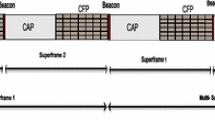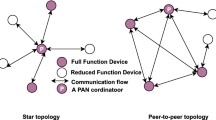Abstract
In this paper, a new analytical model is presented for cluster-based sensor networks using the non-beacon-enabled mode of IEEE802.15.4 MAC protocol. To accurately investigate the impact of MAC parameters and the number of clusters in the cluster-based networks, a new discrete-time Markov chain model is proposed. To be more realistic and practical, these networks employ time-division multiple access and non-beacon-enabled IEEE 802.15.4 protocols for the intra-cluster and inter-cluster communications, respectively. The model parameters are derived from the characteristics of discrete-time Markov chain models. Three network parameters including packet delivery ratio, packet delay and energy consumption per successful packet transmission are derived from the model for performance evaluation. The results of the proposed model are validated with Monte Carlo simulation results.















Similar content being viewed by others
References
Heinzelman, W. R., Chandrakasan, A., & Balakrishnan, H. (2000). Energy-efficient communication protocol for wireless microsensor networks. In Proceedings of the 33rd annual Hawaii international conference on system sciences (Vol. 1, p. 10). IEEE Comput. Soc. https://doi.org/10.1109/hicss.2000.926982.
Rajendra Prasad, D., Naganjaneyulu, P. V., & Satya Prasad, K. (2018). Modified LEACH protocols in wireless sensor networks—A review. In S. C. Satapathy, V. Bhateja, P. S. R. Chowdary, V. V. S. S. S. Chakravarthy, & J. Anguera (Eds.), Proceedings of 2nd international conference on micro-electronics, electromagnetics and telecommunications (Vol. 434, pp. 681–688). Singapore: Springer. https://doi.org/10.1007/978-981-10-4280-5_72.
Singh, S. K., Kumar, P., & Singh, J. P. (2017). A survey on successors of LEACH protocol. IEEE Access, 5(2), 4298–4328. https://doi.org/10.1109/ACCESS.2017.2666082.
Akkari, W., Bouhdid, B., & Belghith, A. (2015). LEATCH: Low energy adaptive tier clustering hierarchy. Procedia Computer Science, 52(1), 365–372. https://doi.org/10.1016/j.procs.2015.05.110.
Singh, D., & Nayak, S. K. (2015). Enhanced modified LEACH (EMODLEACH) protocol for WSN. In 2015 International symposium on advanced computing and communication (ISACC) (pp. 328–333). IEEE. https://doi.org/10.1109/isacc.2015.7377364.
Razaque, A., Mudigulam, S., Gavini, K., Amsaad, F., Abdulgader, M., & Krishna, G. S. (2016). H-LEACH: Hybrid-low energy adaptive clustering hierarchy for wireless sensor networks. In 2016 IEEE long island systems, applications and technology conference (LISAT) (pp. 1–4). IEEE. https://doi.org/10.1109/lisat.2016.7494136.
Lin, D., & Wang, Q. (2017). A game theory based energy efficient clustering routing protocol for WSNs. Wireless Networks, 23(4), 1101–1111. https://doi.org/10.1007/s11276-016-1206-2.
Tarhani, M., Kavian, Y. S., & Siavoshi, S. (2014). SEECH: Scalable energy efficient clustering hierarchy protocol in wireless sensor networks. IEEE Sensors Journal, 14(11), 3944–3954. https://doi.org/10.1109/JSEN.2014.2358567.
Siavoshi, S., Rashvand, H. F., Kavian, Y. S., & Tarhani, M. (2016). Geographical multi-layered energy-efficient clustering scheme for ad hoc distributed wireless sensor networks. IET Wireless Sensor Systems, 6(1), 1–9. https://doi.org/10.1049/iet-wss.2014.0086.
Heinzelman, W. B., Chandrakasan, A. P., & Balakrishnan, H. (2002). An application-specific protocol architecture for wireless microsensor networks. IEEE Transactions on Wireless Communications, 1(4), 660–670. https://doi.org/10.1109/TWC.2002.804190.
Liang, C.-K., Huang, Y.-J., & Lin, J.-D. (2008). An energy efficient routing scheme in wireless sensor networks. In 22nd international conference on advanced information networking and applications—Workshops (aina workshops 2008) (Vol. 3, pp. 916–921). IEEE. https://doi.org/10.1109/waina.2008.199.
Chan, H., & Perrig, A. (2004). ACE: An emergent algorithm for highly uniform cluster formation. In Estudis D’Historia Contemporania del Pais Valencia, ISSN 0210-8704, No. 3, 1982, pp. 403–408 (pp. 154–171). https://doi.org/10.1007/978-3-540-24606-0_11.
Kiran, M. P. R. S., Prasad, Y. R. V., & Rajalakshmi, P. (2017). Modeling and analysis of IEEE 802.15.4 multi-hop networks for IoT applications. Wireless Personal Communications, 100(2), 429–448. https://doi.org/10.1007/s11277-017-5082-6.
Aminian, M. (2013). A hospital healthcare monitoring system using wireless sensor networks. Journal of Health & Medical Informatics, 04(02), 4–9. https://doi.org/10.4172/2157-7420.1000121.
Xiao, Y., Takahashi, D., Liu, J., Deng, H., & Zhang, J. (2011). Wireless telemedicine and m-health: technologies, applications and research issues. International Journal of Sensor Networks, 10(4), 202. https://doi.org/10.1504/IJSNET.2011.042770.
Alim Al Islam, A. B. M. (2010). Finding the optimal percentage of cluster heads from a new and complete mathematical model on LEACH. Wireless Sensor Network, 02(02), 129–140. https://doi.org/10.4236/wsn.2010.22018.
Wang, L., Wang, C., & Liu, C. (2009). Optimal number of clusters in dense wireless sensor networks: A cross-layer approach. IEEE Transactions on Vehicular Technology, 58(2), 966–976. https://doi.org/10.1109/TVT.2008.928637.
Raghuvanshi, A. S., Tiwari, S., Tripathi, R., & Kishor, N. (2010). Optimal number of clusters in wireless sensor networks: An FCM approach. 2010 International conference on computer and communication technology (ICCCT), 817–823. https://doi.org/10.1109/iccct.2010.5640391.
Ranjan, R., & Kar, S. (2011). A novel approach for finding optimal number of cluster head in wireless sensor network. In 2011 National conference on communications (NCC) (pp. 1–5). https://doi.org/10.1109/ncc.2011.5734751.
Elhabyan, R., Shi, W., & St-Hilaire, M. (2018). A Pareto optimization-based approach to clustering and routing in wireless sensor networks. Journal of Network and Computer Applications, 114, 57–69. https://doi.org/10.1016/j.jnca.2018.04.005.
Pollin, S., Ergen, M., Ergen, S., Bougard, B., Der Perre, L., Moerman, I., et al. (2008). Performance analysis of slotted carrier sense IEEE 802.15.4 medium access layer. IEEE Transactions on Wireless Communications, 7(9), 3359–3371. https://doi.org/10.1109/twc.2008.060057.
Pollin, S., Ergen, M., Ergen, S. C., Bougard, B., Van Der Perre, L., Catthoor, F., et al. (2006). WLC10-5: Performance analysis of slotted carrier sense IEEE 802.15.4 medium access layer. In IEEE Globecom 2006 (pp. 1–6). IEEE. https://doi.org/10.1109/glocom.2006.672.
Misic, J., Misic, V. B., & Shafi, S. (2004). Performance of IEEE 802.15.4 beacon enabled PAN with uplink transmissions in non-saturation mode—Access delay for finite buffers. In 1st international conference on broadband networks (pp. 416–425). IEEE Comput. Soc. https://doi.org/10.1109/broadnets.2004.61.
Bianchi, G. (2000). Performance analysis of the IEEE 802.11 distributed coordination function. IEEE Journal on Selected Areas in Communications, 18(3), 535–547. https://doi.org/10.1109/49.840210.
He, Jianhua, Tang, Z., Chen, Hsiao Hwa, & Wang, Shu. (2008). An accurate Markov model for slotted CSMA/CA algorithm in IEEE 802.15.4 networks. IEEE Communications Letters, 12(6), 420–422. https://doi.org/10.1109/lcomm.2008.071460.
Li, X., & Hunter, D. K. (2012). Four-dimensional Markov chain model of single-hop data aggregation with IEEE 802.15.4 in wireless sensor networks. Wireless Networks, 18(5), 469–479. https://doi.org/10.1007/s11276-011-0412-1.
Kim, T. O., Kim, H., Lee, J., Park, J. S., & Choi, B. D. (2006). Performance analysis of IEEE 802.15.4 with non-beacon-enabled CSMA/CA in non-saturated Condition. In Embedded and ubiquitous computing: International conference, EUC 2006, Seoul, Korea, August 1–4, 2006. Proceedings (pp. 884–893). Berlin: Springer. https://doi.org/10.1007/11802167_89.
Kim, T. O., Park, J. S., Kim, K. J., & Choi, B. D. (2009). Performance analysis of IEEE 802.15.4 non-beacon mode with both uplink and downlink traffic in non-saturated condition (pp. 357–371). https://doi.org/10.1007/978-3-642-03819-8_34.
Misic, J., Shafi, S., & Misic, V. B. (2006). Performance of a beacon enabled IEEE 802.15.4 cluster with downlink and uplink traffic. IEEE Transactions on Parallel and Distributed Systems, 17(4), 361–376. https://doi.org/10.1109/tpds.2006.54.
Parsa, M., Motamedi, S. A., Safdarkhani, H., & Maadani, M. (2015). Performance evaluation of beacon enabled IEEE 802.15.4 network with downlink and uplink traffic and limited retransmission. International Journal of Ad Hoc and Ubiquitous Computing, 18(3), 164. https://doi.org/10.1504/ijahuc.2015.068130.
Singh, C. K., Kumar, A., & Ameer, P. M. (2008). Performance evaluation of an IEEE 802.15.4 sensor network with a star topology. Wireless Networks, 14(4), 543–568. https://doi.org/10.1007/s11276-007-0043-8.
Di Marco, P., Park, P., Fischione, C., & Johansson, K. H. (2010). Analytical modelling of IEEE 802.15.4 for multi-hop networks with heterogeneous traffic and hidden terminals. In GLOBECOM—IEEE global telecommunications conference (pp. 1–6). https://doi.org/10.1109/glocom.2010.5683811.
Di Marco, P., Park, P., Fischione, C., & Johansson, K. H. (2012). Analytical modeling of multi-hop IEEE 802.15.4 networks. IEEE Transactions on Vehicular Technology, 61(7), 3191–3208. https://doi.org/10.1109/tvt.2012.2201221.
Zhu, J., Tao, Z., & Lv, C. (2012). Performance analyses and improvements for the IEEE 802.15.4 CSMA/CA scheme with heterogeneous buffered conditions. Sensors, 12(4), 5067–5104. https://doi.org/10.3390/s120405067.
Sahoo, P. K., & Sheu, J.-P. (2017). Design and analysis of collision free MAC for wireless sensor networks with or without data retransmission. Journal of Network and Computer Applications, 80, 10–21. https://doi.org/10.1016/j.jnca.2016.12.020.
Ouanteur, C., Aïssani, D., Bouallouche-Medjkoune, L., Yazid, M., & Castel-Taleb, H. (2016). Modeling and performance evaluation of the IEEE 802.15.4e LLDN mechanism designed for industrial applications in WSNs. Wireless Networks, 23(5), 1343–1358. https://doi.org/10.1007/s11276-016-1226-y.
Park, P., Di Marco, P., Soldati, P., Fischione, C., & Johansson, K. H. (2009). A generalized Markov chain model for effective analysis of slotted IEEE 802.15.4. In 2009 IEEE 6th international conference on mobile adhoc and sensor systems, MASS’09 (pp. 130–139). https://doi.org/10.1109/mobhoc.2009.5337007.
Park, P., Di Marco, P., Fischione, C., & Johansson, K. H. (2013). Modeling and optimization of the IEEE 802.15.4 protocol for reliable and timely communications. IEEE Transactions on Parallel and Distributed Systems, 24(3), 550–564. https://doi.org/10.1109/tpds.2012.159.
Xiao, Z., Zhou, J., Yan, J., He, C., Jiang, L., & Trigoni, N. (2018). Performance evaluation of IEEE 802.15.4 with real time queueing analysis. Ad Hoc Networks, 73, 80–94. https://doi.org/10.1016/j.adhoc.2018.01.006.
Ortin, J., Cesana, M., Redondi, A. E. C., Canales, M., & Gallego, J. R. (2018). Analysis of unslotted IEEE 802.15.4 networks with heterogeneous traffic classes. IEEE Wireless Communications Letters, 2337(c), 1–1. https://doi.org/10.1109/lwc.2018.2873347.
IEEE Std 802.15.4: wireless medium access control (MAC) and physical layer (PHY) specifications for low-rate wireless personal area networks (WPANs). (2011). IEEE Standards Association. Retrieved February 3, 2019, from https://standards.ieee.org/getieee802.
Ramachandran, I., & Roy, S. (2006). WLC46-2: On the impact of clear channel assessment on MAC performance. In IEEE Globecom 2006 (pp. 1–5). IEEE. https://doi.org/10.1109/glocom.2006.884.
Khanafer, M., Guennoun, M., & Mouftah, H. T. (2014). A survey of beacon-enabled IEEE 802.15.4 MAC protocols in wireless sensor networks. IEEE Communications Surveys & Tutorials, 16(2), 856–876. https://doi.org/10.1109/surv.2013.112613.00094.
Park, P., Di Marco, P., Fischione, C., & Johansson, K. H. (2013). Modeling and optimization of the IEEE 802.15.4 protocol for reliable and timely communications. IEEE Transactions on Parallel and Distributed Systems, 24(3), 550–564. https://doi.org/10.1109/tpds.2012.159.
Kim, T. O., Park, J. S., Kim, K. J., & Choi, B. D. (2009). Performance analysis of IEEE 802.15.4 non-beacon mode with both uplink and downlink traffic in non-saturated condition (pp. 357–371). Berlin: Springer. https://doi.org/10.1007/978-3-642-03819-8_34.
Author information
Authors and Affiliations
Corresponding author
Additional information
Publisher's Note
Springer Nature remains neutral with regard to jurisdictional claims in published maps and institutional affiliations.
Rights and permissions
About this article
Cite this article
Hadaidian Nejad Yousefi, H., Seifi Kavian, Y. & Mahmoudi, A. A markov model for investigating the impact of IEEE802.15.4 MAC layer parameters and number of clusters on the performance of wireless sensor networks. Wireless Netw 25, 4415–4430 (2019). https://doi.org/10.1007/s11276-019-02105-4
Published:
Issue Date:
DOI: https://doi.org/10.1007/s11276-019-02105-4




